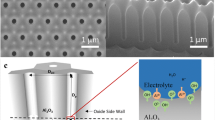Abstract
The porous anodic alumina membranes (PAAMs) have been successfully used as templates for the fabrication of functional nano-materials due to their outstanding regularity and physicochemical properties. In this paper, a transparent double-sided anodic alumina membrane with ultra-thin aluminum substrate was fabricated with the three-step anodic oxidation method in the oxalic acid electrolyte. The characters such as the top-surface morphology, membrane thickness, and depth of nanopores of this three-layer (Al2O3-Al-Al2O3) sandwiched nano-structure were controllable through regulating the main anodic oxidation conditions, e.g., anodic oxidation time of various steps, coating remove process. The experiments data revealed that the aluminum substrate is exponential declined with the oxidation time when it was approximately reduced by a few micrometers. This new double-sided anodic alumina membrane can be used as the high-quality functional field emission materials and templates.
Similar content being viewed by others
References
Fologea D, Gershow M, Ledden B, et al. Detecting single stranded dna with a solid state nanopore. Nano Lett, 2005, 5: 1905–1909
Kim Y, Jung B, Lee H, et al. Capacitive humidity sensor design based on anodic aluminum oxide. Sensors Actuators B, 2009, 141: 441–446
Mizeikis V, Mikulskas I, Tomasiunas R, et al. Optical characteristics of two-dimensional photonic crystals in anodic aluminum oxide films. Jpn J Appl Phys, 2004, 43: 3643–3648
Dong S K, Lee H U, Kim N H, et al. Fabrication of microchannel containing nanopillar arrays using micromachined AAO (anodic aluminum oxide) mold. Microeletronic Eng, 2007, 84: 1532–1535
Che G L, Lakshmi B B, Fisher E R, et al. Carbon nanotubule membranes for electrochemical energy storage and production. Nature, 1998, 393: 346–349
Chik H, Xu J M. Nanometric superlattices: Non-lithographic fabrication, materials, and prospects. Mater Sci Eng R, 2004, 43: 103–138
Deb P, Kim H Y, Rawat V, et al. Faceted and vertically aligned gan nanorod arrays fabricated without catalysts or lithography. Nano Lett, 2005, 5: 1847–1851
Feng L., Li S H, Li Y S, et al. Super-hydrophobic surfaces: From natural to artificial. Adv Mater, 2002, 14: 1857–1860
Ran C B, Ding G Q, Liu W C, et al. Wetting on nanoporous alumina surface: Transition between wenzel and cassie states controlled by surface structure. Langmuir, 2008, 24: 9952–9955
Li Q, Wang K G, Xi D, et al. A kind of synthetic nanopillar arrays for studying single biomolecule. J Nanosci Nanotechnol, 2010, 10: 7447–7450
Wang K, Dang W, Xi D, et al. Hybridised functional micro-and nanostructure for studying the kinetics of a single biomolecule. Micro Nano Lett, 2011, 6: 292–295
Hui D, Wang K G, Zhao X J, et al. The competition of the retraction and capillary forces during the DNA molecules moving within channels. Key Eng Mat, 2011, 483: 331–335
Kondo T, Juodkazis S, Misawa H. Reduction of capillary force for high-aspect ratio nanofabrication. Appl Phys A, 2005, 81: 1583–1586
Shirota Y, Kageyama H. Charge carrier transporting molecular materials and their applications in devices. Chem Rev, 2007, 107: 953–1010
Haberkorn N, Gutmann J S, Theato P. Template-assisted fabrication of free-standing nanorod arrays of a hole-conducting cross-linked triphenylamine derivative: Toward ordered bulk-heterojunction solar cells. ACS Nano, 2009, 3: 1415–1422
Masuda H, Fukuda K. Ordered metal nanohole arrays made by a two-step replication of honeycomb structures of anodic alumina. Science, 1995, 268: 1466–1468
Mikulskas I, Juodkazis S, Tomašiūnas R, et al. Aluminum oxide photonic crystals grown by a new hybrid method. Adv Mater, 2001, 13: 1574–1577
Kwon N, Kim K, Heo J, et al. Fabrication of ordered anodic aluminum oxide with matrix arrays of pores using nanoimprint. J Vac Sci Technol A, 2009, 27: 803–807
Chen B, Lu K, Tian Z P. Novel patterns by focused ion beam guided anodization. Langmuir, 2011, 27: 800–808
Chen B, Lu K. Moiré pattern nanopore and nanorod arrays by focused ion beam guided anodization and nanoimprint molding. Langmuir, 2011, 27: 4117–4125
Kasi A K, Kasi J K, Afzulpurkar N, et al. Bending and branching of anodic aluminum oxide nanochannels and their applications. J Vac Sci Technol B, 2012, 30: 031805
Hsieh C L, Lo P H, Fang W. Dual-layer nanoporous anodic aluminum oxide with embedded electrodes for capacitive relative humidity sensor. The 17th International Conference, Barcelona: IEEE, 2013, 2572–2575
Author information
Authors and Affiliations
Corresponding author
Rights and permissions
About this article
Cite this article
Zhang, C., Wang, K., Gao, Z. et al. A kind of double-sided porous anodic alumina membrane fabricated with the three-step anodic oxidation method. Sci. China Technol. Sci. 57, 293–297 (2014). https://doi.org/10.1007/s11431-014-5466-8
Received:
Accepted:
Published:
Issue Date:
DOI: https://doi.org/10.1007/s11431-014-5466-8




